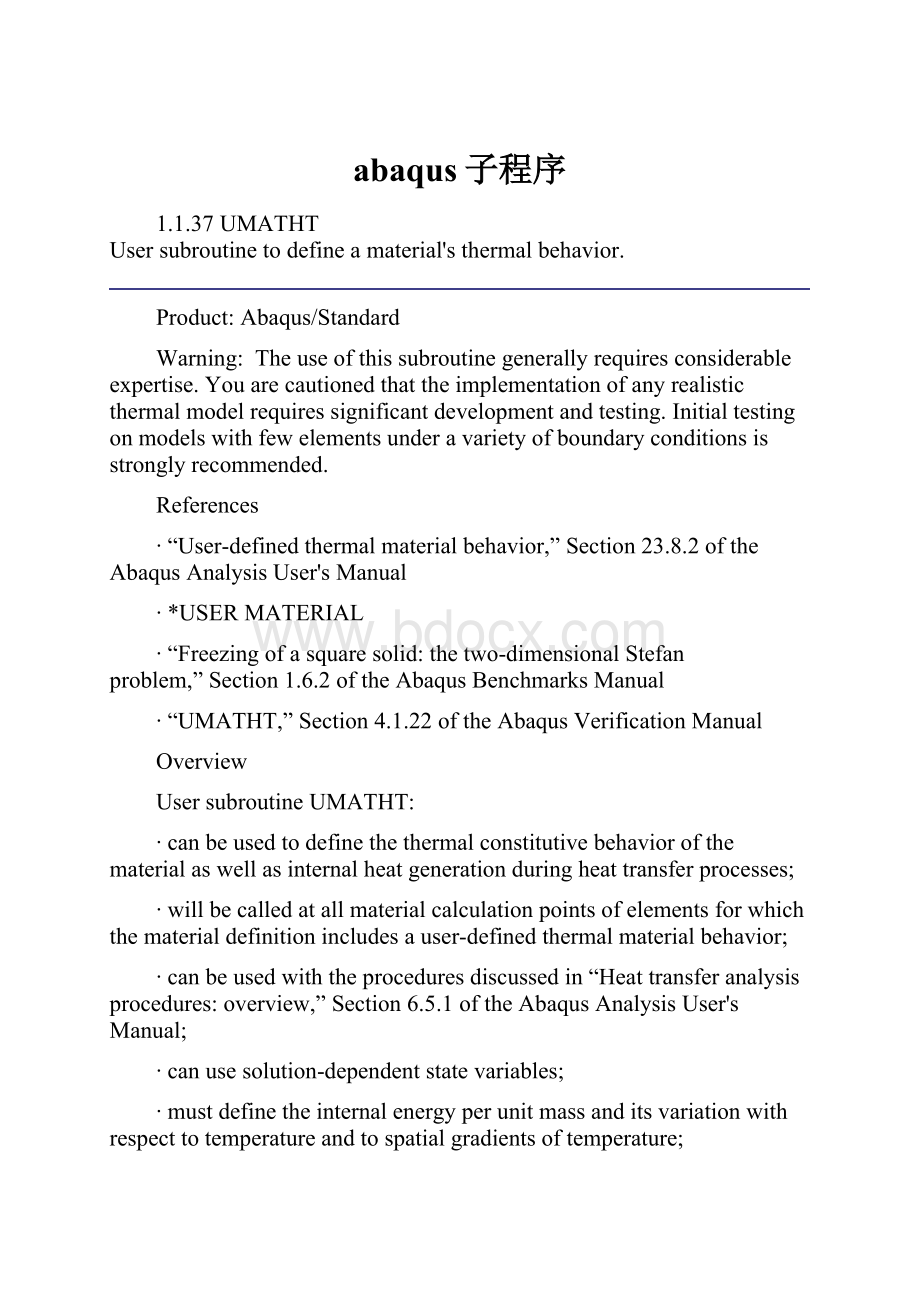abaqus子程序.docx
《abaqus子程序.docx》由会员分享,可在线阅读,更多相关《abaqus子程序.docx(14页珍藏版)》请在冰豆网上搜索。

abaqus子程序
1.1.37 UMATHT
Usersubroutinetodefineamaterial'sthermalbehavior.
Product:
Abaqus/Standard
Warning:
Theuseofthissubroutinegenerallyrequiresconsiderableexpertise.Youarecautionedthattheimplementationofanyrealisticthermalmodelrequiressignificantdevelopmentandtesting.Initialtestingonmodelswithfewelementsunderavarietyofboundaryconditionsisstronglyrecommended.
References
∙“User-definedthermalmaterialbehavior,” Section23.8.2oftheAbaqusAnalysisUser'sManual
∙*USERMATERIAL
∙“Freezingofasquaresolid:
thetwo-dimensionalStefanproblem,” Section1.6.2oftheAbaqusBenchmarksManual
∙“UMATHT,” Section4.1.22oftheAbaqusVerificationManual
Overview
Usersubroutine UMATHT:
∙canbeusedtodefinethethermalconstitutivebehaviorofthematerialaswellasinternalheatgenerationduringheattransferprocesses;
∙willbecalledatallmaterialcalculationpointsofelementsforwhichthematerialdefinitionincludesauser-definedthermalmaterialbehavior;
∙canbeusedwiththeproceduresdiscussedin “Heattransferanalysisprocedures:
overview,” Section6.5.1oftheAbaqusAnalysisUser'sManual;
∙canusesolution-dependentstatevariables;
∙mustdefinetheinternalenergyperunitmassanditsvariationwithrespecttotemperatureandtospatialgradientsoftemperature;
∙mustdefinetheheatfluxvectoranditsvariationwithrespecttotemperatureandtogradientsoftemperature;
∙mustupdatethesolution-dependentstatevariablestotheirvaluesattheendoftheincrement;
∙canbeusedinconjunctionwithusersubroutine USDFLD toredefineanyfieldvariablesbeforetheyarepassedin;and
∙isdescribedfurtherin “User-definedthermalmaterialbehavior,” Section23.8.2oftheAbaqusAnalysisUser'sManual.
Useofsubroutine UMATHT withcoupledtemperature-displacementelements
Usersubroutine UMATHT shouldbeusedonlywithreduced-integrationormodifiedcoupledtemperature-displacementelementsifthemechanicalandthermalfieldsarenotcoupledthroughplasticdissipation.Nosuchrestrictionexistswithfullyintegratedcoupledtemperature-displacementelements.
Usersubroutineinterface
SUBROUTINEUMATHT(U,DUDT,DUDG,FLUX,DFDT,DFDG,
1STATEV,TEMP,DTEMP,DTEMDX,TIME,DTIME,PREDEF,DPRED,
2CMNAME,NTGRD,NSTATV,PROPS,NPROPS,COORDS,PNEWDT,
3NOEL,NPT,LAYER,KSPT,KSTEP,KINC)
C
INCLUDE'ABA_PARAM.INC'
C
CHARACTER*80CMNAME
DIMENSIONDUDG(NTGRD),FLUX(NTGRD),DFDT(NTGRD),
1DFDG(NTGRD,NTGRD),STATEV(NSTATV),DTEMDX(NTGRD),
2TIME
(2),PREDEF
(1),DPRED
(1),PROPS(NPROPS),COORDS(3)
usercodingtodefineU,DUDT,DUDG,FLUX,DFDT,DFDG,
andpossiblyupdateSTATEV,PNEWDT
RETURN
END
Variablestobedefined
U
Internalthermalenergyperunitmass, U,attheendofincrement.Thisvariableispassedinasthevalueatthestartoftheincrementandmustbeupdatedtoitsvalueattheendoftheincrement.
DUDT
Variationofinternalthermalenergyperunitmasswithrespecttotemperature,
evaluatedattheendoftheincrement.
DUDG(NTGRD)
Variationofinternalthermalenergyperunitmasswithrespecttothespatialgradientsoftemperature,
attheendoftheincrement.Thesizeofthisarraydependsonthevalueof NTGRD asdefinedbelow.Thistermistypicallyzeroinclassicalheattransferanalysis.
FLUX(NTGRD)
Heatfluxvector,
attheendoftheincrement.Thisvariableispassedinwiththevaluesatthebeginningoftheincrementandmustbeupdatedtothevaluesattheendoftheincrement.
DFDT(NTGRD)
Variationoftheheatfluxvectorwithrespecttotemperature,
evaluatedattheendoftheincrement.
DFDG(NTGRD,NTGRD)
Variationoftheheatfluxvectorwithrespecttothespatialgradientsoftemperature,
attheendoftheincrement.Thesizeofthisarraydependsonthevalueof NTGRD asdefinedbelow.
Variablesthatcanbeupdated
STATEV(NSTATV)
Anarraycontainingthesolution-dependentstatevariables.
Inanuncoupledheattransferanalysis STATEV ispassedinto UMATHT withthevaluesofthesevariablesatthebeginningoftheincrement.However,anychangesin STATEV madeinusersubroutine USDFLD willbeincludedinthevaluespassedinto UMATHT,since USDFLD iscalledbefore UMATHT.Inaddition,if UMATHT isbeingusedinafullycoupledtemperature-displacementanalysisandusersubroutine CREEP,usersubroutine UEXPAN,usersubroutine UMAT,orusersubroutine UTRS isusedtodefinethemechanicalbehaviorofthematerial,thoseroutinesarecalledbeforethisroutine;therefore,anyupdatingof STATEV donein CREEP, UEXPAN, UMAT,or UTRS willbeincludedinthevaluespassedinto UMATHT.
Inallcases STATEV shouldbepassedbackfrom UMATHT asthevaluesofthestatevariablesattheendofthecurrentincrement.
PNEWDT
Ratioofsuggestednewtimeincrementtothetimeincrementbeingused(DTIME,seebelow).ThisvariableallowsyoutoprovideinputtotheautomatictimeincrementationalgorithmsinAbaqus/Standard(ifautomatictimeincrementationischosen).
PNEWDT issettoalargevaluebeforeeachcallto UMATHT.
If PNEWDT isredefinedtobelessthan1.0,Abaqus/Standardmustabandonthetimeincrementandattemptitagainwithasmallertimeincrement.ThesuggestednewtimeincrementprovidedtotheautomatictimeintegrationalgorithmsisPNEWDT × DTIME,wherethe PNEWDT usedistheminimumvalueforallcallstousersubroutinesthatallowredefinitionof PNEWDT forthisiteration.
If PNEWDT isgivenavaluethatisgreaterthan1.0forallcallstousersubroutinesforthisiterationandtheincrementconvergesinthisiteration,Abaqus/Standardmayincreasethetimeincrement.Thesuggestednewtimeincrementprovidedtotheautomatictimeintegrationalgorithmsis PNEWDT × DTIME,wherethe PNEWDT usedistheminimumvalueforallcallstousersubroutinesforthisiteration.
Ifautomatictimeincrementationisnotselectedintheanalysisprocedure,valuesof PNEWDT thataregreaterthan1.0willbeignoredandvaluesof PNEWDT thatarelessthan1.0willcausethejobtoterminate.
Variablespassedinforinformation
TEMP
Temperatureatthestartoftheincrement.
DTEMP
Incrementoftemperature.
DTEMDX(NTGRD)
Currentvaluesofthespatialgradientsoftemperature,
TIME
(1)
Valueofsteptimeatthebeginningofthecurrentincrement.
TIME
(2)
Valueoftotaltimeatthebeginningofthecurrentincrement.
DTIME
Timeincrement.
PREDEF
Arrayofinterpolatedvaluesofpredefinedfieldvariablesatthispointatthestartoftheincrement,basedonthevaluesreadinatthenodes.
DPRED
Arrayofincrementsofpredefinedfieldvariables.
CMNAME
User-definedmaterialname,leftjustified.
NTGRD
Numberofspatialgradientsoftemperature.
NSTATV
Numberofsolution-dependentstatevariablesassociatedwiththismaterialtype(definedasdescribedin “Allocatingspace”in“Usersubroutines:
overview,” Section15.1.1oftheAbaqusAnalysisUser'sManual).
PROPS(NPROPS)
User-specifiedarrayofmaterialconstantsassociatedwiththisusermaterial.
NPROPS
User-definednumberofmaterialconstantsassociatedwiththisusermaterial.
COORDS
Anarraycontainingthecoordinatesofthispoint.Thesearethecurrentcoordinatesinafullycoupledtemperature-displacementanalysisifgeometricnonlinearityisaccountedforduringthestep(see “Procedures:
overview,” Section6.1.1oftheAbaqusAnalysisUser'sManual);otherwise,thearraycontainstheoriginalcoordinatesofthepoint.
NOEL:
Elementnumber.
NPT:
Integrationpointnumber.
LAYER:
Layernumber(forcompositeshellsandlayeredsolids).
KSPT:
Sectionpointnumberwithinthecurrentlayer.
KSTEP:
Stepnumber.
KINC:
Incrementnumber.
Example:
Usingmorethanoneuser-definedthermalmaterialmodel
Tousemorethanoneuser-definedthermalmaterialmodel,thevariable CMNAME canbetestedfordifferentmaterialnamesinsideusersubroutine UMATHT,asillustratedbelow:
IF(CMNAME(1:
4).EQ.'MAT1')THEN
CALLUMATHT_MAT1(argument_list)
ELSEIF(CMNAME(1:
4).EQ.'MAT2')THEN
CALLUMATHT_MAT2(argument_list)
ENDIF
UMATHT_MAT1 and UMATHT_MAT2 aretheactualusermaterialsubroutinescontainingtheconstitutivematerialmodelsforeachmaterial MAT1 and MAT2,respectively.Subroutine UMATHT merelyactsasadirectoryhere.Theargumentlistcanbethesameasthatusedinsubroutine UMATHT.
Example:
Uncoupledheattransfer
Asasimpleexampleofthecodingofusersubroutine UMATHT,consideruncoupledheattransferanalysisinamaterial.Theequationsforthiscasearedevelopedhere,andthecorresponding UMATHT isgiven.Thisproblemcanalsobesolvedbyspecifyingthermalconductivity,specificheat,density,andinternalheatgenerationdirectly.
First,theequationsforanuncoupledheattransferanalysisareoutlined.
Thebasicenergybalanceis
where V isthevolumeofsolidmaterialwithsurfacearea S,
isthedensityofthematerial,
isthematerialtimerateoftheinternalthermalenergy, q istheheatfluxperunitareaofthebodyflowingintothebody,and r istheheatsuppliedexternallyintothebodyperunitvolume.
Aheatfluxvector
isdefinedsuchthat
where
istheunitoutwardnormaltothesurface S.Introducingtheaboverelationintotheenergybalanceequationandusingthedivergencetheorem,thefollowingrelationisobtained:
Thecorrespondingweakformisgivenby
where
isthetemperaturegradientand
isanarbitraryvariationalfieldsatisfyingtheessentialboundaryconditions.
Introducingthebackwarddifferenceintegrationalgorithm:
theweakformoftheenergybalanceequationbecomes
ThisnonlinearsystemissolvedusingNewton'smethod.
Intheaboveequationsthethermalconstitutivebehaviorofthematerialisgivenby
And
where
arestatev